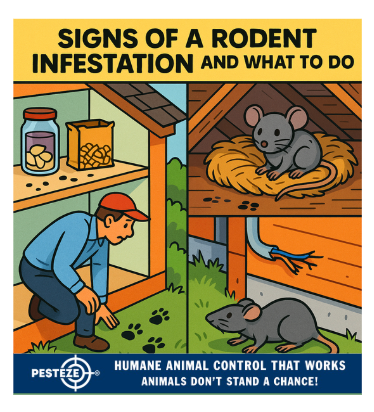SIGNS OF A RODENT INFESTATION AND WHAT TO DO

SIGNS OF A RODENT INFESTATION AND WHAT TO DO
SUMMARY
This guide explains the most reliable signs that mice or rats are present in or near your home and gives clear, practical steps to confirm, contain, and resolve infestations safely. It focuses on detection, safe cleanup, exclusion (sealing entry points), and choosing humane or professional removal methods.
FEATURES
-
Droppings & Urine Odor: Fresh pellets and a musky smell in cupboards, basements, or attics.
-
Gnaw Marks & Chewed Packaging: Damaged wires, boxes, and wood near food stores.
-
Nocturnal Noises: Scratching, scurrying, or squeaks inside walls and ceilings at night.
-
Tracks & Grease Marks: Footprints, tail marks, or oily smudges along baseboards.
-
Nesting Material: Shredded paper, fabric, or insulation piled in hidden spots.
-
Pet Alerts & Daytime Sightings: Pets acting alert or seeing rodents in daylight (often a high-population sign).
GUIDE DESCRIPTION
Rodents reproduce quickly and are expert at hiding, so catching an infestation early saves time, money, and health risks. Start your inspection with the most obvious indicators. Look for fresh droppings—small, dark pellets—near food storage, inside cupboards, and along baseboards. Fresh gnaw marks on food boxes, wiring, or wood are reliable evidence; chew marks darken and appear ragged. Listen after dark for the characteristic scratching or scampering in walls, attics, or ceilings—rodents are usually active at night.
When you suspect rodents, confirm safely. Wear disposable gloves and an N95 mask before inspecting areas with droppings or nests. Do not sweep or vacuum fresh droppings (this can aerosolize pathogens). Instead ventilate the area for 30 minutes, spray disinfectant and let it soak, then wipe up with paper towels and seal waste in a bag. If you’re uncomfortable handling droppings or suspect a larger infestation, call a professional. Secure immediate food sources—store food in airtight containers, put pet food away, and clean up crumbs or spills.
Containment and exclusion are the long-term solution. Rodents squeeze through very small holes—mice through dime-sized gaps, rats through quarter-sized openings. Inspect foundations, door jams, dryer vents, and gaps around pipes. Seal holes with steel wool and caulk, sheet metal, hardware cloth, or cement. Install door sweeps and replace damaged vent covers. Reduce outdoor attractants by securing garbage, trimming vegetation away from the house, storing firewood off the ground, and removing clutter where rodents can hide.
Choose removal methods appropriate to infestation size and local rules. For small problems, live-capture traps or snap traps placed carefully can work—check traps frequently and handle captured animals with gloves. Many public-health agencies advise caution about relocating rodents because of disease and ecological risks; check local laws before releasing animals. For large infestations, suspected structural damage, or evidence of disease, hire a licensed pest-control professional who will apply targeted control, cleanup, and follow-up inspections.
Finally, prevention is ongoing. Repair leaks (rodents need water), maintain tidy storage, schedule periodic inspections, and document repairs. After control, monitor for new signs and re-seal any new entry points promptly. Acting early, cleaning safely, sealing effectively, and using the right removal method will protect your home, family health, and—when possible—reduce unnecessary harm to animals.
- Saneeth Thota


Comments 0